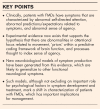Neurobiology of functional (psychogenic) movement disorders
- PMID: 23823467
- PMCID: PMC4196785
- DOI: 10.1097/WCO.0b013e3283633953
Neurobiology of functional (psychogenic) movement disorders
Abstract
Purpose of review: This review explores recent developments in understanding the neurobiological mechanism of functional (psychogenic) movement disorders (FMDs). This is particularly relevant given the resurgence of academic and clinical interest in patients with functional neurological symptoms and the clear shift in diagnostic and treatment approaches away from a pure psychological model of functional symptoms.
Recent findings: Recent research findings implicate three key processes in the neurobiology of FMD (and by extension other functional neurological symptoms): abnormal attentional focus, abnormal beliefs and expectations, and abnormalities in sense of agency. These three processes have been combined in recent neurobiological models of FMD in which abnormal predictions related to movement are triggered by self-focused attention, and the resulting movement is generated without the normal sense of agency that accompanies voluntary movement.
Summary: New understanding of the neurobiology of FMD forms an important part of reappraising the way that patients with FMD (and other functional disorders) are characterized and treated. It also provides a testable framework for further exploring the pathophysiology of these common causes of ill health.
References
-
- Stone J, Edwards MJ. How ‘psychogenic’ are psychogenic movement disorders? Mov Disord 2011; 26:1787–1788 - PubMed
-
- Espay AJ, Goldenhar LM, Voon V, et al. Opinions and clinical practices related to diagnosing and managing patients with psychogenic movement disorders: an international survey of Movement Disorder Society members. Mov Disord 2009; 24:1366–1374 - PubMed
-
- Stone J, LaFrance WC, Jr, Brown R, et al. Conversion disorder: current problems and potential solutions for DSM-5. J Psychosom Res 2011; 71:369–376 - PubMed
Publication types
MeSH terms
LinkOut - more resources
Full Text Sources
Other Literature Sources
Medical
Research Materials


